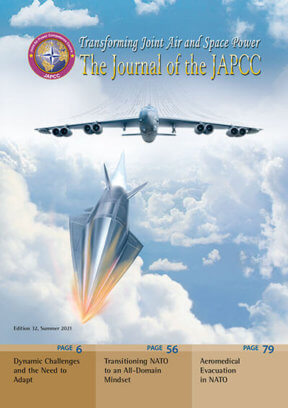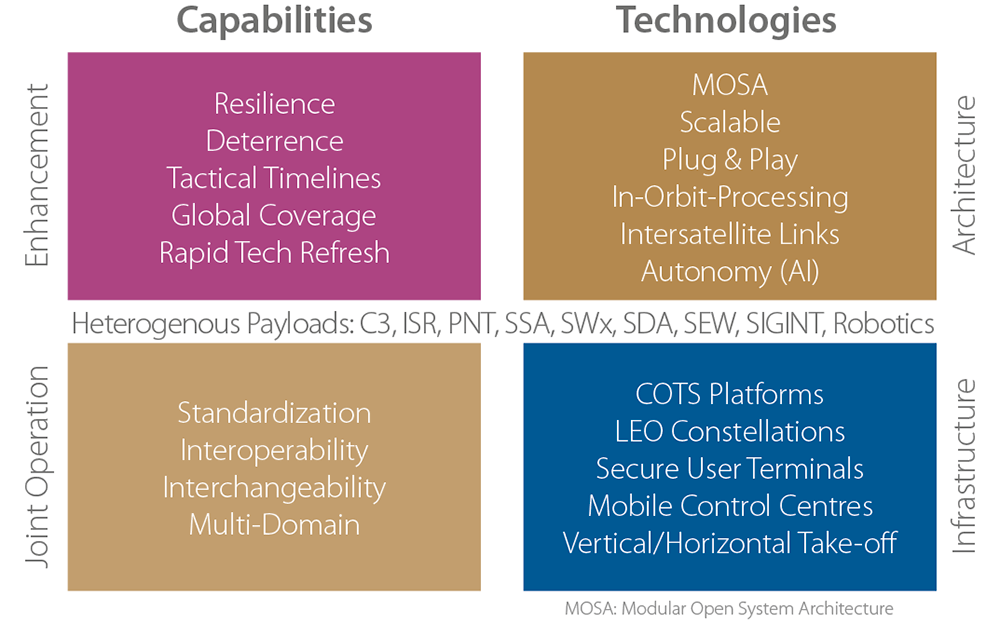Introduction
Space Support plays a significant role in today’s modern warfare and is a key enabler for NATO’s technical and operational advantage. Worldwide technical developments challenge this advantage while Space has become congested and contested.
This is the second article of a series focusing on the Responsive Space topic. The first article was released within JAPCC Journal 31 in December 2020 and focused on definitions as well as international doctrinal concepts. This article is more technically focused and will complement the third and final one, scheduled for release in Journal 33, which will discuss and analyze a potential outcome for NATO.
The first article can be accessed here.
Responsive Space Developments of NATO and Its Member Nations
The aim is to give the reader a short but not too comprehensive overview about recent technological developments. Already addressed in a previous article (JAPCC Journal 27)1 worldwide Responsive Launch capabilities will not be assessed here again. This article can be accessed here.
NATO
NATO does not yet use the term Responsive Space. Due to its multinational approach as an alliance of 30-member nations, research on procedures that can be categorized as Responsive Space are mainly focused on interoperability, whether via governmental Space-based assets or via commercially available services and assets.2 Interoperability, data sharing and continuous mission support is one of the key principles of NATO.
United States
The US launched a programme called Operationally Responsive Space (ORS), which was based on Responsive Launch Capabilities for launchers as well as satellite solutions. Subsequently, an ORS Office was established in 2018 to coordinate the programme and was renamed to the Space Rapid Capabilities Office (SpRCO).3 It still coordinates across the whole Department of Defense with several projects focused on combatant commanders’ needs such as the development of low cost rapidly usable Space technology to fulfil an array of joint military requirements. The office is also responsible for the development and fielding of such Space technology and makes it available to the NATO warfighter.
The Pentagon’s new Space Development Agency (SDA)4 will orchestrate the development and fielding of the future National Defense Space Architecture. This will be a single, coherent proliferated space architecture with seven layers:
- A global, persistent, low-latency data and communication transport layer.
- Indications, warning, tracking, and targeting of advanced missile threats.
- 24/7, all-weather constant custody of time-sensitive targets.
- Low-latency battle management to enable time-sensitive kill chain closure.
- Space situational awareness and rapid access for deterrence in cislunar volume (the space between the earth and the moon).
- Alternate Position, Navigation, and Timing (PNT) for GPS-denied environments.
- Ground systems and launch capabilities to support a responsive and resilient space architecture.
SDA will rely heavily on Defence Advanced Research Projects Agency’s (DARPA) Blackjack programme.5 That programme aims to develop and demonstrate the critical elements for a global high-speed network in Low Earth Orbit (LEO) providing the Department of Defense with a highly connected, resilient, and persistent coverage.
Germany
On behalf of the German Ministry of Defence, the Responsive Space Cluster Competence Center (RSC3) of the German Aerospace Center (Deutsches Zentrum für Luft- und Raumfahrt [DLR]) explores the technological basis for a national Responsive Space Capability and demonstrates key technologies in Space. To do this, RSC3 draws on DLR’s decades of experience and systems competence in Aerospace as well as Defence and Security research. The overall aim is to develop flexible and affordable, rapidly available methods and technologies for operational capabilities that enable small military satellites launched into LEO to become operational within a few days on-demand and on-call.
A major element will be the involvement of users and industry already in the Research and Development (R&D) process. The RSC3 takes on a coordinating role in Germany aiming to accelerate the technological refresh cycle significantly. For this purpose, it is essential to accomplish ongoing technological demonstrations and to ensure a regular technological transfer of data from research to industry in order to operate the latest state-of-the-art military products in Space. Standardized interfaces allow an easier data exchange in a multi-domain environment towards the improvement of joint operations. Additionally, they lower the entry threshold for Small Medium Enterprises and start-up companies facilitating seamless synergies between military and civil applications.
New technological requirements and possibilities arise from the use of small satellites in swarms, constellations or as single platforms. A modular and open system architecture is a key requirement and needs to be explored, in order to support rapid interchangeability of Commercial-Off-The-Shelf (COTS) satellite platforms and the integration of a diverse array of components that are required to establish plug & play payloads from Space functional areas such as Satellite Communication (SatCom), Intelligence, Surveillance and Reconnaissance (ISR), PNT, etc. Reducing the amount of data through on-board processing, and a high degree of autonomy with the support of AI-based algorithms, are further key elements that need to be investigated and tested (Figure 1). Amongst the mentioned technologies, an agile and robust operation or control of individual small satellites or entire constellations will be essential to enhance the effectiveness of military operations.
Figure 1: Examples of Key Elements of a Responsive Space Capability. © DLR
Space Capability
Globally available launch sites and multiple launch service providers, which offer either ground-, sea-, or airborne small satellite launchers with Responsive Space Capability, ensure short-term availability, increase the resilience of the launch segment and will benefit on demand quick reaction space operations. Launcher systems with liquid propulsion are not excluded in advance provided they can be refuelled and launched within a few days.
In addition to the aforementioned Space and launch segment, the ground segment completes the holistic approach of a Responsive Space System Architecture.6 Mobile control centres and optical ground receiving stations, as well as reactive planning tools, optimized transfer orbits and accelerated commissioning procedures are in development.
Consequently, research and development needs to be undertaken in various areas to benefit the future war-fighter.
The requirements and technological demonstration missions are currently defined in coordination with the Ministry of Defence, subordinate authorities and in cooperation with the University of the Armed Forces. The RSC3 will demonstrate key technologies as soon as 2021.
Multilateral Approaches
One specific discussion forum, the Responsive Space Capabilities (RSC) Memorandum of Understanding (MOU), needs to be addressed. It is a multinational framework agreement involving the Departments and Ministries of Defence of Australia, Canada, Germany, Italy, Netherlands, New Zealand, Norway, the United Kingdom and the United States.
The overall objective of the RSC MOU is to define and establish the general principles that will apply to the initiation, conduct, and management of Research, Development, Test and Evaluation (RDT&E) cooperation projects detailed in separate Project Arrangements (PAs). Additionally, the MOU allows the exchange of information for harmonizing the participants’ military requirements and to assist in defining potential cooperative efforts.
Germany participates in the following three PAs:
- Responsive Launch and Range (ReLaR) is responsible for exploration, identification, and assessment system concepts for launch and range and technologies reducing launch costs as well as increasing responsive launch capabilities.
- Micro-Satellite Military Utility (MSMU) is required to explore the military utility of a diverse space architecture including traditional government and commercial satellites, as well as micro- and nano-satellites and their value to an operational theatre.
- Military Optical Satellite Communications and Optical Space Data Relay (MOSCOM) is responsible for the exploration of the military benefit to free-space optical satellite communications and the standardization of laser-based direct-to-Earth links using a network of interoperable optical ground stations among the partner nations.
Out of the authors’ experiences there are additional multilateral discussions in several workshops on responsively usable Space approaches ongoing. The majority of these discussions are exchanges of experiences related to technology standardization and interoperability. The use of future Space architectures such as mega-constellations is also addressed.
Responsive Space Developments Worldwide
Responsive Space is an evolving discipline of military Space support. Most of the ongoing research and development proceeds are restricted. Therefore, it is hard to find and assess information about potential adversaries’ capabilities. As a discipline of Space intelligence this information is often classified. To give the reader a slight overview, the projects that are addressed in the following chapter are based on unclassified and well assessed research subjects, but it does not cover all existing projects.
People’s Republic of China
In 2015, China established the Strategic Support Force (SSF)7 which is responsible for all military Space support inside the Peoples Liberation Army (PLA). The SSF is therefore also responsible for the Responsive Space capabilities for the PLA. As of yet, it is not known what stage the establishment is at, but China’s Responsive Space is mainly focused on the networking and interaction of already deployed satellites. Due to the enormous number of already launched Chinese ISR satellites, this approach works well in this function.8 The large number of official civilian, but government-owned offices, agencies, and companies that operate the different satellites on behalf of the government allow this.9 At least one of the PLA’s military universities is researching on how to interconnect existing and future constellations.10 China has also developed, as a Responsive Launch capability, an inexpensive and mobile launch technology, based on military missile systems allowing replacement of in-orbit degraded systems in the event of an armed conflict.11
Russian Federation
In August 2015, Russia created the Russian Federation Aerospace forces which, at that time, included the Russian Space Forces responsible for Space launches (dual-use, as well as military), satellite operations and operation of the missile defence early warning systems, the satellite control network as well as the Space Object Surveillance and Identification (SOSI) network.12 Notwithstanding the need for protection of Russia against all kinds or airborne and missile threats, the protection against space threats is also directly addressed.13
Planned to be operational in 2028, the ‘SPHERA’ project, is a complex SatCom Mega-Constellation in LEO.14 This constellation also integrates payloads from different platforms such as ISR in an interconnected approach. The ISR equipped satellites of ‘SPHERA’ are codenamed as ‘BERKUT’. The constellation will be operated by the Russian Space Agency, ROSCOSMOS, which ensures a military usability, either generally or on request. To ensure a persistent communication service, SPHERA is already projected to integrate platforms other than Space-based systems such as high-altitude airborne platforms or ground-based networks inside Russia. This approach of separating systems into its unique components ensures a high level of robustness.
Interim Assessment and Conclusion
As already stated in the first article, conceptual approaches of Responsive Space are under discussion and in development nearly worldwide. Several approaches in technical developments are being addressed. While the western world is mainly focused on interoperability and standardization, the People’s Republic of China, particularly, follows a specific network driven approach. Software solutions to secure network centric support is by their definition the key to responsiveness. Looking into recent commercial Space developments, especially dedicated mega constellations for ISR or SATCOM, seem to be the drivers at least within the next decade. These represent opportunities for militarily usable Responsive Space applications, too.
Further adaptation of national conceptual approaches as well as technical developments for NATO frameworks in standardization and interoperability to support resilient Joint All-Domain Operations (JADO) have to be explored. This includes processes, concepts of operations and technologies15 to identify solutions for connecting systems across domains and enabling synchronized effects. A deeper analysis on this will be included in the third and final article of this series.















